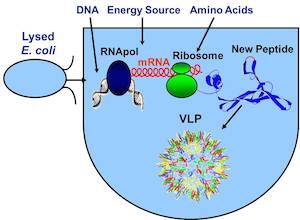Biochemical / Biomedical Research
Vaccine Design / Virus-based Nanoparticles

Faculty: Bradley C. Bundy
Dr. Bundy's lab works on protein engineering of virus-like particles for vaccine development, drug delivery, and imaging applications. Their recent work focuses on the incorporation of a single unique A2 protein into the Qbeta VLP which could then be used as a unique site for bioconjugation of the desired biochemical moiety to the particle. Their recent paper that has been accepted in vaccine, Foot-and-mouth disease: Technical and political challenges to eradication, can be read online.
More information:
Cell-free Synthetic Biology

Faculty: Bradley C. Bundy
Cell-free Synthetic Biology research is focused on the engineering and optimization of a cell-free system for protein expression and protein engineering. A cell-free approach enables direct access to the biocatalytic environment and thus direct control of enzyme and reactant concentrations.
More information:
Biocatalysis Immobilization

Faculty: Bradley C. Bundy
A major focus of Dr. Bundy's research lab is the site-specific incorporation of unnatural amino acids into biocatalysist for the orientation-controlled covalent surface-immobilization.
More information:
Ultrasonic Activated Drug and Gene Delivery

Faculty: William G. Pitt
Over the past decade we have found that anti-cancer drugs can be sequestered inside small carrier vesicles that can be injected into the blood stream and travel throughout the body within the circulatory system, and then be released from the carrier at a precise location and timing using ultrasonic irradiation. The drug carriers keep the drug from being released prematurely and interacting with healthy tissues, resulting in side effects. We are actively studying this method of drug delivery, and are designing drug carriers.
Transport in Contact Lenses

Faculty: William G. Pitt
Dr. Pitt has been studying theoretical aspects of the transport of oxygen and ions in soft contact lenses since 2006. Recently he and his students have conducting experiments on the transport of phospholipids in silicone hydrogel contact lenses, with the aim of using the contact lens as a depot to slowly release phospholipids to the tears bathing the cornea. This technology could be used to increase the comfort of wearing contact lenses, particularly by people who lack adequate phospholipids, and thus who often have dry or itching eyes.